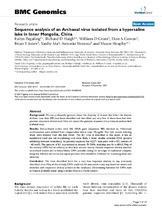Sequence analysis of an Archaeal virus isolated from a hypersaline lake in Inner Mongolia, China
Date
2007Author
Pagaling, Eulyn
Haigh, Richard D.
Grant, William D.
Cowan, Donald A.
Jones, Brian
Ma, Yanhe
Ventosa, Antonio
Heaphy, Shaun
Metadata
Show full item recordAbstract
Background: We are profoundly ignorant about the diversity of viruses that infect the domain
Archaea. Less than 100 have been identified and described and very few of these have had their
genomic sequences determined. Here we report the genomic sequence of a previously undescribed
archaeal virus.
Results: Haloarchaeal strains with 16S rRNA gene sequences 98% identical to Halorubrum
saccharovorum were isolated from a hypersaline lake in Inner Mongolia. Two lytic viruses infecting
these were isolated from the lake water. The BJ1 virus is described in this paper. It has an
icosahedral head and tail morphology and most likely a linear double stranded DNA genome
exhibiting terminal redundancy. Its genome sequence has 42,271 base pairs with a GC content of
~65 mol%. The genome of BJ1 is predicted to encode 70 ORFs, including one for a tRNA. Fifty of
the seventy ORFs had no identity to data base entries; twenty showed sequence identity matches
to archaeal viruses and to haloarchaea. ORFs possibly coding for an origin of replication complex,
integrase, helicase and structural capsid proteins were identified. Evidence for viral integration was
obtained.
Conclusion: The virus described here has a very low sequence identity to any previously
described virus. Fifty of the seventy ORFs could not be annotated in any way based on amino acid
identities with sequences already present in the databases. Determining functions for ORFs such
as these is probably easier using a simple virus as a model system.

